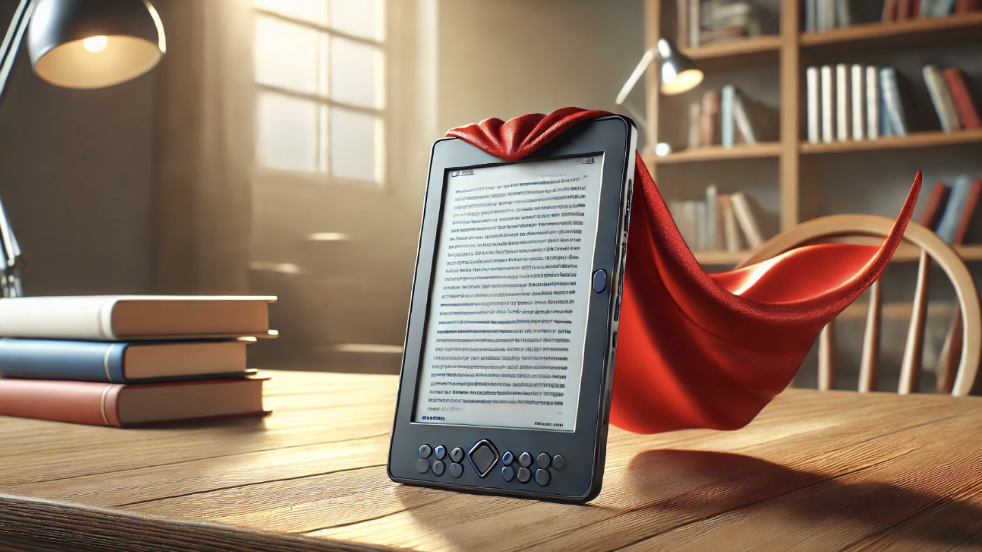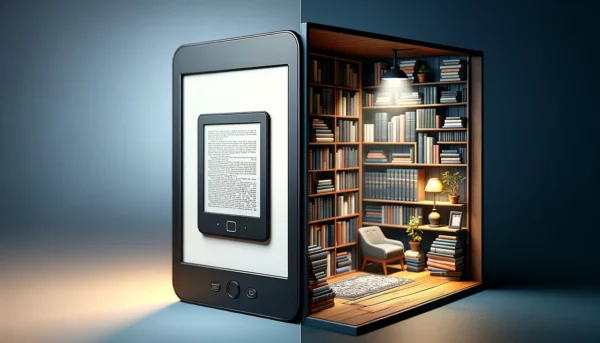Let’s be honest—your bookshelf is more decorative than functional at this point. Half the books are sun-faded, the other half are propping up a struggling houseplant, and you haven’t opened Moby-Dick since the Great Quarantine Clean-Up of 2020. Enter the ebook: the sleek, silent hero of the digital reading age.
So, what is an ebook? In the simplest terms, an ebook (short for electronic book) is a book you can read on a screen instead of flipping through physical pages. But don’t be fooled by the simplicity—ebooks are more than just text in a tech wrapper. They’re shapeshifters that can live in your phone, your tablet, your laptop, or your Kindle, ready to spring to life at the swipe of a finger.
In this article, we’re unpacking the ebook universe: what ebooks are, how they work, the formats they come in, and the kinds of content they can hold (spoiler: it’s a lot). Whether you’re curious about ebook creation services or just tired of lugging paperbacks through airport security, you’re in the right place. Let’s crack the (digital) spine and explore new options.
What Is an Ebook, Really? The Digital Book, Debunked
So, what is an ebook, really? Think of it as the book world’s answer to streaming music. Just like you no longer need a stack of CDs to enjoy your favorite tunes, you no longer need a mountain of paperbacks to get your reading fix. An ebook, short for electronic book or digital book, is a book presented in a digital format, designed to be read on screens—whether it’s a Kindle, a tablet, a phone, or even your crusty old laptop.
Formally, an ebook is a digital file that contains the content of a book—text, images, and sometimes even multimedia elements—formatted to be read electronically. Informally? It’s a book that won’t weigh down your backpack, judge you for reading romantasy at work, or suffer coffee-stained pages.
Now, before you picture a crusty PDF attachment from your boss and think “been there, read that,” hold up. A true ebook is not just a PDF. (Tell your confused uncle it’s like comparing a flip phone to a smartphone. Technically similar, functionally worlds apart.) Ebooks adapt to your screen, let you customize font sizes, add bookmarks, and sometimes even respond to your taps and swipes.
Ebooks matter more than ever in today’s fast-paced, digital-first world. They’re accessible, affordable, and make self-publishing possible for voices that traditional gatekeepers might overlook. Whether you’re devouring novels, diving into DIY guides, or flipping through cookbooks with clickable recipes, ebooks are changing how we read—and who gets to write.
How Does an Ebook Actually Work? (AKA Tech Meets Text)
So, you’ve nailed the answer to the question, ‘what is an ebook?’, but now you’re wondering, ‘what is an ebook and how does it work?’ Great question. No, it’s not witchcraft (though it definitely has some techy magic vibes).
At its core, an ebook is a digital file that lives inside a device, waiting for you to summon it with a tap. You can read ebooks on dedicated e-readers like the Amazon Kindle or Kobo, which are designed specifically for book lovers. Prefer a multi-tasking screen? Tablets, smartphones, and laptops all work, too. Just download an ebook app—like Kindle, Apple Books, Google Play Books, or even the delightfully retro Adobe Digital Editions—and voilà, your virtual bookshelf appears.
Now, here’s where the tech gets slick. Unlike rigid files like PDFs, ebooks are usually in formats like EPUB or MOBI, which are reflowable. That means the text adjusts to fit your screen, your font size preference, and even your mood (dark mode fans, unite). You’re not just flipping through static pages—you’re swiping through a dynamic, responsive experience.
Think of ebooks like shapeshifting scrolls: elegant, efficient, and endlessly adaptable. They live in your device’s storage (usually taking up way less space than your average vacation selfie album), and can sync across platforms. Start reading on your phone during your commute, then pick up where you left off on your tablet at home.
It’s not just “words on a screen”—it’s a whole new way to interact with books. And the best part? No bookmarks are required.
Your Publishing Journey Awaits – Start NowEbook Formats: Not All Files Are Created Equal
Let’s talk files. If you’ve ever tried to open an ebook and gotten a face full of error messages, welcome to the wacky world of ebook formats. So, what is an ebook format, exactly? Simply put, it’s the file type your ebook is saved in—the digital DNA that determines how it looks and behaves and which devices will tolerate its presence.
Imagine a family reunion. EPUB is the cool cousin—it’s flexible, widely loved, and gets along with nearly everyone (except Kindle, of course). MOBI is Kindle’s childhood best friend, but it is a bit outdated now. PDF is the rigid uncle who refuses to change font size. And AZW? That’s Amazon’s secret sauce—proprietary, polished, and slightly elitist.
Here’s a breakdown of the big players:
| Format | Best For | Pros | Cons |
| EPUB | Most devices and apps | Flexible layout, reflowable, open standard | Not natively supported on Kindle |
| MOBI | Older Kindles | Works on Kindle (used to) | Largely obsolete, limited features |
| AZW/Kindle | Amazon devices | Optimized for Kindle, supports DRM | Limited to Kindle ecosystem |
| Fixed-layout documents | Universal, preserves formatting | Not reflowable, hard to read on small screens | |
| IBA | Apple Books | Interactive ebooks with media | Only works on Apple devices |
Each format has itsown vibe, and choosing the right one depends on your reader, your device, and whether you enjoy font freedom or layout rigidity.
So next time someone throws around terms like EPUB or AZW, you can nod knowingly, channel your inner techie, and maybe even explain why Uncle PDF still insists on being printed out.
What Is an Ebook Example? Let’s Get Specific
Alright, theory is great—but what is an ebook example you can actually picture? Spoiler: If you’ve ever read The Hunger Games on your phone at midnight or highlighted passages from Atomic Habits on a Kindle, congrats—you’ve already met an ebook in the wild.
Ebooks aren’t just for fiction lovers (though they’re paradise for binge-readers of fantasy and romance). They cover just about every genre and purpose under the sun:
- Fiction: Novels, short story collections, serialized sci-fi sagas—ebooks are a favorite for modern fiction readers.
- Nonfiction: Think self-help, business guides, biographies, and anything Tim Ferriss has ever written.
- Cookbooks: Beautifully designed with clickable indexes and step-by-step instructions.
- Textbooks: Used in schools and universities, with features like search functions and embedded quizzes.
- Children’s books: Interactive pages, read-along audio, animations—basically, bedtime stories on caffeine.
You’ll find these digital gems on platforms like the Amazon Kindle Store, Apple Books, Google Play Books, and Kobo. Whether you’re reading on a sleek Kindle Paperwhite or just the cracked screen of your smartphone, there’s an ebook format ready to roll.
So next time someone asks, what is an ebook example? you can casually reference Becoming by Michelle Obama, The Subtle Art of Not Giving a F*ck, or even your kid’s favorite talking dinosaur story. Ebooks are everywhere—you just need to tap in.
Why Ebooks Are Basically Superheroes in Disguise
Let’s be real—ebooks don’t wear capes, but they do have powers. If you’ve ever tried to squeeze six novels into a carry-on, you already know their greatest strength: portability. With an ebook, your entire library can live in your pocket. That’s right—Tolstoy and TikTok can coexist on the same device (no judgment).
But it’s not just about convenience. Ebooks are champions of accessibility. Want bigger text? Done. Need a high-contrast screen or a text-to-speech reader? No problem. Ebooks adapt to you, not the other way around. Whether you’re visually impaired, dyslexic, or just hate squinting, ebooks are ready to rise to the occasion.
They’re also budget-friendly sidekicks. Many classics are free, and new titles are often cheaper than their print counterparts. Plus, ebooks have cracked the publishing code wide open. Thanks to platforms like Amazon KDP and Draft2Digital, indie authors can now publish without begging a gatekeeper for approval. More voices, more stories, more diversity. That’s a win for readers and writers.
And let’s not forget the planet. Ebooks don’t chop down trees, guzzle water, or require shipping trucks. Mother Nature sends her regards.
Oh, and perhaps their most underrated power? Ebooks don’t judge. You can read vampire werewolf billionaire romance at 2 a.m. with zero side-eye. No awkward covers to hide. No librarian whispering “Really?” under their breath.
So yes, ebooks may not wear superhero spandex, but they do save the day—one digital page at a time.
You, Too, Can Master the Ebook Realm
By now, you’ve unlocked the secrets of the digital scroll. From understanding what an ebook is to exploring formats, devices, and dazzling examples, you’re officially ebook-savvy—and maybe even a little enchanted.
Whether you’re a voracious reader craving convenience or a budding author ready to share your words with the world, ebooks offer a universe of possibilities. They’re powerful, portable, and packed with potential—not just a modern twist on reading, but a revolution in how we consume and create stories.
So go ahead—download that novel, publish that guide, explore that app. The ebook realm is wide open, and it’s waiting for your next swipe, tap, or turn of the (virtual) page.
FAQs – What is an Ebook?
Q1: How much do ebooks cost?
Ebooks can cost anywhere from $0 to $20+, depending on the publisher, author, and publishing platform. Many classics are completely free, while new releases tend to be cheaper than their print versions. Indie authors often price ebooks at just a few bucks—so yes, your next favorite read might cost less than a latte.
Q2: How can I start writing an ebook?
Start with an idea you’re excited about—whether it’s a how-to guide, a memoir, or the next big sci-fi saga. Then, outline your chapters, set small writing goals, and draft away (coffee helps). Once you’ve got your words down, you can format your manuscript using tools like Microsoft Word, Google Docs, or ebook-specific software like Scrivener or Reedsy. When it’s ready to launch into the digital universe, platforms like Amazon KDP, Apple Books, and Draft2Digital make publishing surprisingly painless. Bonus tip: With Spines, you can create, publish, and manage your ebook all in one streamlined space.
Q3: What is the difference between an ebook and a digital book?
Honestly? They’re pretty much twins. “Ebook” and “digital book” are often used interchangeably. Technically, a digital book could include PDFs or other formats that don’t adapt well to different screens, while an ebook is usually designed for a smooth, flexible reading experience across devices.
Q4: Will ebooks replace printed books?
Not likely. Ebooks are growing in popularity, but print books still have their charm (and that new-book smell). It’s not a competition—it’s a beautiful coexistence. Think Spotify and vinyl records: different vibes, both here to stay.
Q5: Will an ebook read to me?
Some will! Many ebook apps and devices offer text-to-speech or syncing with audiobooks so you can listen on the go. Just make sure your ebook and reader support that feature—otherwise, you’ll have to rely on your own inner narrator.
Q6: Do you have to have a Kindle to read an ebook?
Nope! While Kindles are great, they’re not mandatory. You can read ebooks on just about any device—smartphones, tablets, laptops, or desktops—using free apps like Kindle, Apple Books, or Google Play Books. The ebook world is device-agnostic and super inclusive.








